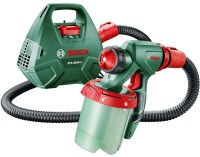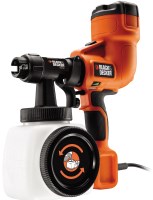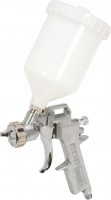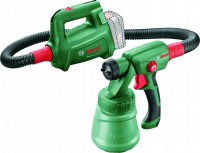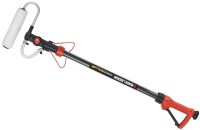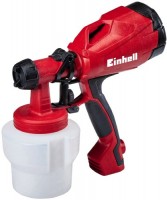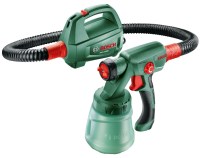Paint Sprayers Sealey
All Paint Sprayers Advanced filters → |
You might be interested in
Paint Sprayers: specifications, types
Device
— Airbrush. General purpose spray guns — in other words, traditional spray guns that do not belong to any of the specialized categories described below. At the same time, the functionality of such devices can be quite diverse — from relatively small tools for hard-to-reach areas and small areas to quite powerful performant solutions that are already approaching paint stations.
— Airbrush. A miniature variety of spray g...uns, distinguished primarily by very small nozzle sizes — less than 1 mm, and more often up to 0.5 mm. Thanks to this, airbrushes are optimally suited for delicate work, where accuracy is most important; with the help of such a tool, you can even create full-fledged paintings (for example, those same “airbrushes” that adorn cars).
— Roller. An improved version of the conventional paint roller, supplemented by a paint supply system. Thanks to this, additional convenience is provided during work: there is no need to periodically dip the roller into a container with paint, and the coating itself is applied as accurately and evenly as possible.
— Plaster. A variety of spray guns used not for painting, but for plastering. One of the characteristic features of such tools is the large diameter of the nozzle: thanks to this, it is not clogged with mortar particles and is easily cleaned after work is completed. In addition, plaster guns are usually equipped with rather large (about 5 – 7 liters) own tanks; such a reservoir is usually supplemented with a handle for the convenience of holding the tool with the second hand.
— Paint station. Units designed for large volumes of work, where high performance is of decisive importance. A mandatory feature of paint stations are remote compressors (see below) of high power and large size, usually mounted on a stand or even a trolley for ease of transportation. And often there is no own paint tank at all, and the working composition is supplied from an external container (for example, a bucket). Also note that painting stations often allow two guns to be connected to one compressor at once (see below).
— Airbrush. A miniature variety of spray g...uns, distinguished primarily by very small nozzle sizes — less than 1 mm, and more often up to 0.5 mm. Thanks to this, airbrushes are optimally suited for delicate work, where accuracy is most important; with the help of such a tool, you can even create full-fledged paintings (for example, those same “airbrushes” that adorn cars).
— Roller. An improved version of the conventional paint roller, supplemented by a paint supply system. Thanks to this, additional convenience is provided during work: there is no need to periodically dip the roller into a container with paint, and the coating itself is applied as accurately and evenly as possible.
— Plaster. A variety of spray guns used not for painting, but for plastering. One of the characteristic features of such tools is the large diameter of the nozzle: thanks to this, it is not clogged with mortar particles and is easily cleaned after work is completed. In addition, plaster guns are usually equipped with rather large (about 5 – 7 liters) own tanks; such a reservoir is usually supplemented with a handle for the convenience of holding the tool with the second hand.
— Paint station. Units designed for large volumes of work, where high performance is of decisive importance. A mandatory feature of paint stations are remote compressors (see below) of high power and large size, usually mounted on a stand or even a trolley for ease of transportation. And often there is no own paint tank at all, and the working composition is supplied from an external container (for example, a bucket). Also note that painting stations often allow two guns to be connected to one compressor at once (see below).
Type
The type is indicated by the energy source from which the spray gun operates. Nowadays, you can find pneumatic, electric( mains and battery), as well as mechanical and gasoline models. Here are their main features:
— Pneumatic. Spray guns powered by compressed air from an external compressor. In other words, only a spr...ay gun (gun, airbrush, etc.) is included in the delivery package of such a tool; it requires a separate compressor to operate. At first glance, this creates certain inconveniences; however, such a configuration also has noticeable advantages. Firstly, you do not need to overpay for a compressor if it is already “on the farm” (a separate example of such a situation is a construction site where a powerful stationary compressor is used for several pneumatic tools). Secondly, the nozzle and compressor can be selected at your discretion, without relying on the equipment selected by the manufacturer. Thus, most modern spray guns are made precisely pneumatic. The unambiguous disadvantages of such devices include unsuitability for working with airless spray systems, however, such systems are used much less often than air ones, so this nuance is not key.
— Electric. In this case, spray guns powered by outlets are meant (battery models are placed in a separate category, see below). Devices of this type consist of the nebulizer itself, as well as a compressor (built-in or remote). One of the advantages of this option is just the presence of a compressor, due to which, for the operation of such an airbrush, in fact, only an outlet is needed. In addition, both air and airless spray systems can be used in such units. The disadvantages of electric models include a higher cost than pneumatic ones, as well as the inability to select a working nozzle and a compressor separately — usually, spray guns of this type are sold as ready-made kits.
— Rechargeable. Spray guns equipped with electric compressors powered by their own batteries. The key advantage of such tools is battery life, the ability to work even if there are no outlets nearby. On the other hand, it is difficult to achieve high power and performance with a battery; the time of continuous operation of such atomizers is limited by the battery charge (and a source of electricity will still be required to replenish the charge); and the design itself turns out to be more complicated and more expensive than that of analogues powered by a socket. Therefore, battery spray guns nowadays have not received much distribution.
— Mechanical. Units in which the supply of paint is carried out due to the muscular strength of the user — in other words, for this you need to manually swing the pump lever. This scheme of operation is as simple and reliable as possible, but it is poorly suited for traditional sprayers. Therefore, "mechanics" nowadays is extremely rare, mainly among rollers (see "View").
— Petrol. Models with this type of power supply combine high power and independence from the power grid, but they are rather bulky, more difficult to operate and repair, more expensive (both in terms of their own cost and fuel price) and are generally designed for industrial outdoor use. . Therefore, they are poorly distributed and are used where, for one reason or another, electrical analogues are not applicable.
— Pneumatic. Spray guns powered by compressed air from an external compressor. In other words, only a spr...ay gun (gun, airbrush, etc.) is included in the delivery package of such a tool; it requires a separate compressor to operate. At first glance, this creates certain inconveniences; however, such a configuration also has noticeable advantages. Firstly, you do not need to overpay for a compressor if it is already “on the farm” (a separate example of such a situation is a construction site where a powerful stationary compressor is used for several pneumatic tools). Secondly, the nozzle and compressor can be selected at your discretion, without relying on the equipment selected by the manufacturer. Thus, most modern spray guns are made precisely pneumatic. The unambiguous disadvantages of such devices include unsuitability for working with airless spray systems, however, such systems are used much less often than air ones, so this nuance is not key.
— Electric. In this case, spray guns powered by outlets are meant (battery models are placed in a separate category, see below). Devices of this type consist of the nebulizer itself, as well as a compressor (built-in or remote). One of the advantages of this option is just the presence of a compressor, due to which, for the operation of such an airbrush, in fact, only an outlet is needed. In addition, both air and airless spray systems can be used in such units. The disadvantages of electric models include a higher cost than pneumatic ones, as well as the inability to select a working nozzle and a compressor separately — usually, spray guns of this type are sold as ready-made kits.
— Rechargeable. Spray guns equipped with electric compressors powered by their own batteries. The key advantage of such tools is battery life, the ability to work even if there are no outlets nearby. On the other hand, it is difficult to achieve high power and performance with a battery; the time of continuous operation of such atomizers is limited by the battery charge (and a source of electricity will still be required to replenish the charge); and the design itself turns out to be more complicated and more expensive than that of analogues powered by a socket. Therefore, battery spray guns nowadays have not received much distribution.
— Mechanical. Units in which the supply of paint is carried out due to the muscular strength of the user — in other words, for this you need to manually swing the pump lever. This scheme of operation is as simple and reliable as possible, but it is poorly suited for traditional sprayers. Therefore, "mechanics" nowadays is extremely rare, mainly among rollers (see "View").
— Petrol. Models with this type of power supply combine high power and independence from the power grid, but they are rather bulky, more difficult to operate and repair, more expensive (both in terms of their own cost and fuel price) and are generally designed for industrial outdoor use. . Therefore, they are poorly distributed and are used where, for one reason or another, electrical analogues are not applicable.
Power consumption
The power consumed by the operation of an electric tool (see "Type").
Most modern spray guns, even performant ones, have a rather low power: for example, models with more than 1 kW are extremely rare, and in most cases, power consumption does not exceed 500 W at all. So when connecting such equipment to sockets, there are usually no problems; only single units of high performance, requiring 3.5 kW or more, have to be c...onnected according to special rules (directly to the shield). In other cases, data on power consumption is most often not needed for normal use and may be required only for specific tasks — for example, to calculate the load on an autonomous generator.
Most modern spray guns, even performant ones, have a rather low power: for example, models with more than 1 kW are extremely rare, and in most cases, power consumption does not exceed 500 W at all. So when connecting such equipment to sockets, there are usually no problems; only single units of high performance, requiring 3.5 kW or more, have to be c...onnected according to special rules (directly to the shield). In other cases, data on power consumption is most often not needed for normal use and may be required only for specific tasks — for example, to calculate the load on an autonomous generator.
Rated pressure
Nominal air pressure in the spray gun.
The general meaning of this parameter depends on the type of instrument (see above). So, in pneumatic models, nominal pressure data is required for connection to an external compressor. It is this pressure that this compressor must create at the inlet to the atomizer; too low values will lead to a decrease in efficiency, too high are fraught with breakdowns and even accidents with injury to others.
In turn, for electric models, the nomin...al pressure is the air pressure created by the unit's own compressor; the complete atomizer was originally designed for the same pressure. So in this case, this parameter is more of a reference than practically significant; it may be useful only for connecting replacement nozzles to the compressor (or vice versa, for using an existing nozzle with a third-party compressor).
As for specific pressure values, they are primarily determined by the spray system (see below). The diversity here is quite high: the most modest units give out less than 2 bar, 2-5 bar compressors are quite popular , 5-10 bar models are relatively rare, and some powerful performance solutions provide a pressure of 100 bar or more.
The general meaning of this parameter depends on the type of instrument (see above). So, in pneumatic models, nominal pressure data is required for connection to an external compressor. It is this pressure that this compressor must create at the inlet to the atomizer; too low values will lead to a decrease in efficiency, too high are fraught with breakdowns and even accidents with injury to others.
In turn, for electric models, the nomin...al pressure is the air pressure created by the unit's own compressor; the complete atomizer was originally designed for the same pressure. So in this case, this parameter is more of a reference than practically significant; it may be useful only for connecting replacement nozzles to the compressor (or vice versa, for using an existing nozzle with a third-party compressor).
As for specific pressure values, they are primarily determined by the spray system (see below). The diversity here is quite high: the most modest units give out less than 2 bar, 2-5 bar compressors are quite popular , 5-10 bar models are relatively rare, and some powerful performance solutions provide a pressure of 100 bar or more.
Air consumption
Nominal air flow rate when the spray gun is operating in normal mode.
This parameter is of key importance for a pneumatic tool (see "Type"): the compressor to which such a sprayer is connected must provide the appropriate air supply rate, otherwise normal operation will not be possible. In turn, in electric models, this indicator is more of a reference — the complete compressor, by definition, corresponds to the characteristics of the sprayer, and it makes sense to pay attention to the...flow rate only if the working nozzle of the electric spray gun is planned to be used with a "non-native" compressor.
This parameter is of key importance for a pneumatic tool (see "Type"): the compressor to which such a sprayer is connected must provide the appropriate air supply rate, otherwise normal operation will not be possible. In turn, in electric models, this indicator is more of a reference — the complete compressor, by definition, corresponds to the characteristics of the sprayer, and it makes sense to pay attention to the...flow rate only if the working nozzle of the electric spray gun is planned to be used with a "non-native" compressor.
Paint consumption
Consumption of paint or other material (for example, mortar for plaster) when the spray gun is operating in normal mode.
The higher the flow rate, the more material the tool can apply per unit of time, the better it is suitable for processing large areas and for applying thick coatings. On the other hand, not all types of work require high productivity, and sometimes relatively low consumption is optimal. Detailed recommendations on this subject for different situations can be found in...special sources.
The higher the flow rate, the more material the tool can apply per unit of time, the better it is suitable for processing large areas and for applying thick coatings. On the other hand, not all types of work require high productivity, and sometimes relatively low consumption is optimal. Detailed recommendations on this subject for different situations can be found in...special sources.


